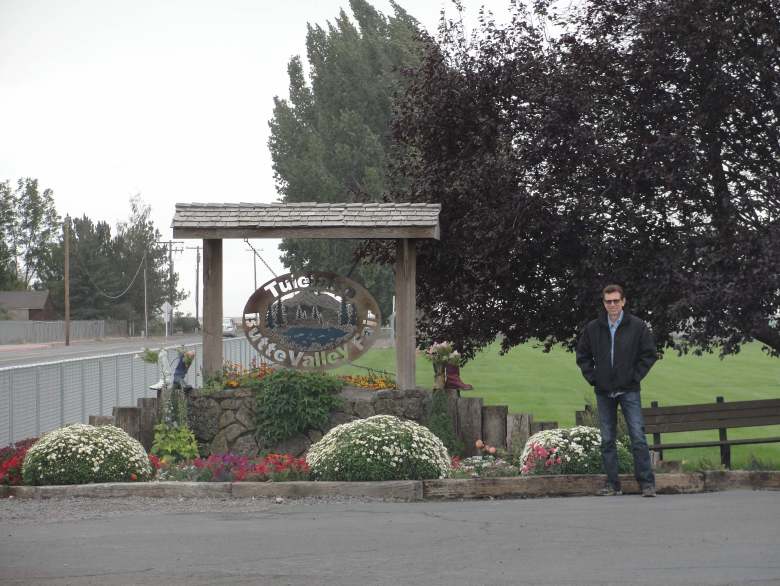
By KYRA KARATSU
Located near the Oregon-California border, the ghost of what once was one of California’s two internment camps now stands rather quietly against a backdrop of mountains and shrubs.
But for much of the 20th century, Tulelake and the nearby town of Newell – where the Tule Lake Segregation Center stands – were no strangers to the bustle of human activity.
A Japanese American relocation camp turned high-security segregation center turned homestead farming community, the Tulelake area has since evolved into a historically significant landscape for a varied miscellany of Americans.
Enter Michael Wells, the son of post-war homesteaders and, incidentally, my best friend’s father.
Sparked when his daughter Jocelyn disclosed that he was raised in a remodeled barrack up north, my interest in his story stems in part from my own relatives, who had a completely different experience with the barracks. After exchanging phone numbers, he graciously allowed me to interview him via email.
Wells’ Tulelake upbringing begins with his father, one of the thousands of World War II veterans who were offered the opportunity to enter a lottery for homestead farms in the Tulelake area.
Along with farmland to cultivate crops (potatoes and wheat in Wells’ case), the homestead farm package included a camp barrack that could be repurposed to fit residents’ needs.

“With the help of others, the barrack was sectioned off (or cut) into two separate buildings,” says Wells, “One ‘half’ became a shed or garage of sorts while the other ‘half’ was remodeled by my dad with the help of a local carpenter into the house I was raised in.”
The veteran homesteaders outside of Wells’ family had similar plans as well, with most of the raffled barracks likewise becoming sheds, garages, or single-family homes. As for the barracks that remained at the site of the camp, he recalls that they were remodeled into rented apartments or “l(fā)odges” for out-of-the-area wildlife hunters.
The community’s size is something that Wells also easily recalls. The town, at its prime, had a population of approximately 1,000, with another 1,000 scattered throughout the area’s farms, thus giving the community “a fairly favorable ‘small’ town feel.” While the population was predominantly white, Mexican Americans also resided in Tulelake either year-round or seasonally as agricultural laborers. However, to Wells’ knowledge, he notes that there were no Japanese Americans who remained in the area after the war.

Demographics aside, the Tulelake area housed a number of businesses and, of course, farmlands.
“Potatoes, wheat, alfalfa, onions, and horseradish were raised in the prime farm areas within the region,” Wells explains, “Cattle were raised in the areas closest to the surrounding hills and mountains, where the soil was less desirable for farming.”
As for local businesses, gas stations, “dime” stores, a pharmacy, a bowling alley, a movie theater, duck and goose cleaning businesses for the wildlife hunters, bars, churches, a handful of motels, grain elevators, and a potato processing plant occupied the town and occasionally served as hangout spots.
“Weekend fun consisted of going over to a nearby friend’s house for the afternoon to play, going to a local movie, or attending various occasional church weekend activities, including also (always) church on Sunday.”
Sports at the local public schools, especially basketball, also kept Wells busy from elementary to high school and is now revered as one of his fondest memories.
Things were not always as idyllic or sunny, however. Wells recalls that binge drinking ran rampant and frequently plagued the small town. With community leaders, school administrators, and even parents often turning a blind eye to the problem, a culture of “out-of-control binge drinking every weekend by the local high school students” occasionally spiraled into DUI accidents.

Yet, despite the good, the bad, and, oftentimes, stagnant aspects of small-town life, Wells’ upbringing offers an individual perspective on the complex and intricate history of Tulelake. The Tule Lake Relocation Center opened in May 1942 before closing as a converted segregation center for supposedly “disloyal” Japanese Americans in March 1946. But for the Wells family and many of the veteran homesteaders, post-war Tulelake was once the chance to build both a new home and a new life.
Wells left Tulelake in September of 1977 to attend Brigham Young University while his parents remained until 1983, when they – like many of the other original homesteaders – sold their land and moved elsewhere.
Although he last revisited the area in 2013, Wells tells me that it has undergone quite the transformation since his childhood. Monuments and memorials now decorate the camp site while inscribed plaques narrate “the era, the events, the life there at the time of the internment.”
Tulelake and nearby Newell have since seen better days as well, with their reduced population sizes and closed businesses giving the towns (as Wells describes it) “a ‘ghost town’ type of appearance.” Nevertheless, Wells chooses to end on a more positive note, as he relays that both the local high school and annual fair continue to thrive.
Wells’ upbringing is a unique examination into how a camp became a community. Since much of my own knowledge of the camps stems from personal testimony – often spoken from the standpoints of interned relatives who recalled the times spent in the Amache, Poston, and Heart Mountain camps – hearing the Wells’ post-war perspective has undoubtedly made for an engaging listen.
From farmland to family, the history of the veteran homesteaders adds yet another layer to the many stories embossed in barrack walls.
Kyra Karatsu is a second-year college student and writes from Santa Clarita. She can be contacted at [email protected].Photos provided by Michael Wells.